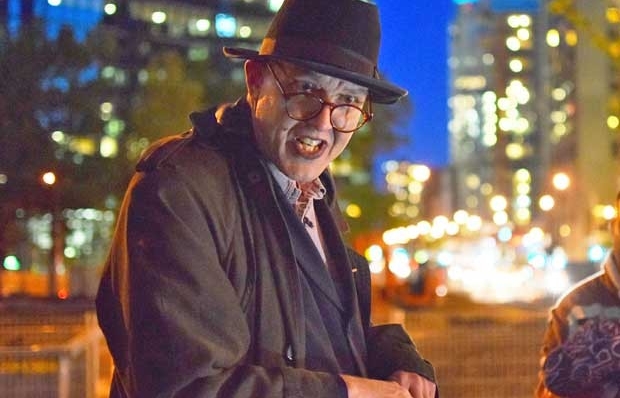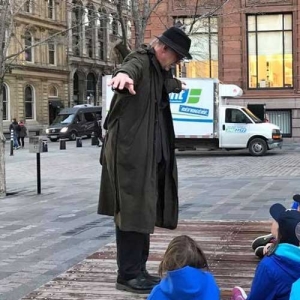In the Victorian era they would be able to talk about things that were otherwise taboo through ghost stories. From venereal diseases to homosexuality to murder, incest — whatever! You could cover all this through ghost stories that would otherwise not be acceptable to tell.”
Tell us about the new company you’re co-founding, Secret Montreal, and the sorts of tours you’re planning.
DK: “Last year I did a red light ghost walk and it was very successful. We’re launching a new burlesque walking tour led by a real burlesque queen, Velma Candyass, this June.
The Quartier des Spectacles was the old red light district. Everyone is still talking about this district, but the city is trying to clean it up, erase it. Let’s keep the little bit that’s left and celebrate it, because it was a fascinating era.”
How did your time at Concordia influence what you do today?
DK: “Louise Chalmers, who taught me about acting and teaching when I was in high school — my career choices to this day — was also teaching at Concordia in the Drama in Education program. I was really fortunate to have somebody like that in my life. It’s amazing to think a teacher can have that sort of influence.
The program had three thrusts. One was drama teaching, the second was theatre activism — or drama for social change — and the third was drama therapy.
I’m heavily involved in theatre activism. I run the Infringement Festival, which is very much rooted in this tradition.”
Tell us about theatre activism.
DK: “I did a master’s degree at University of Calgary, where I really focused on theatre activism. I did a lot of work on stuff like ‘culture jamming,’ which is very is controversial. You’re disrupting societal norms with theatrical performances. Folks like the Yes Men, Michael Moore, the Raging Grannies — all that genre of performance. I love it!
The idea is that someone’s going to get up and protest but they’re not just going to walk down the street with a sign and yell. They’re actually going to integrate some sort of performance that might disrupt something else.”
You were banned for life from the St. Ambroise Montreal Fringe Festival. It started when you insisted a critic pay her way instead of getting a free ticket for your experimental show Car Stories — and it snowballed into a large incident. In reaction, you started the Infringement Festival. How did that develop?
DK: “When we set up the Montreal Fringe in 1991, it was meant to empower artists. Unfortunately the Fringe was trademarked in 1998, meaning it’s very corporate now. We took their logo, crossed out the St. Ambroise [corporate sponsor] name and did a spray paint of ‘in’ and ‘ment’ [around ‘fringe’].
We culture-jammed their logo, we culture-jammed the festival and we started offering the real Fringe, like it was in the old days. It’s a do-it-yourself festival.
People can create their own performance anywhere they want, bring their own venue, but we also have venues that we share, so it all depends on the resources that exist. We often say, ‘Bring what you would hope to find.’
We got invited to the World Fringe Congress in Edinburgh, Scotland, in 2012. This is an academic forum. In 2014 I was invited back to give a workshop and I also did a performance at the Edinburgh Fringe.
Then in 2016 they moved the congress to another city. Where did they select? Montreal! So of course it’s now being run by the same people who kicked us out. In my hometown, I’m not even allowed in. They also excluded artists from the Buffalo Infringement Festival.
So we host a World Infringement Congress. Shona McCarthy [CEO of Edinburgh Fringe Festival Society] comes to ours, with her entourage of about 10 heads of fringe festivals. Even though we had been excluded from the congress this time, we did what any respectable fringe artist would do — create our own!
This all is what I learned at Concordia. I learned how to apply theatre and activism together.”
Are you able to apply activism to your tours?
DK: “The walking tours are able to put certain politics in the spotlight. In the Griffintown ghost walk, you learn that the building of the Lachine Canal saw the first strike in Canadian history because they cut their salaries by a third.
When they read the riot act and workers refused to disperse, the sergeant ordered his soldiers to fire into the crowd. And they did. So all these workers were shot in the back and died.
These kinds of messages are embedded in the stories and can speak to contemporary issues as well. Things like poverty, labour issues, feminist issues, queer issues. Here you’re looking at social history and oppression, and it’s all coming out through a ghost story.”
#CUalumni
Related links


 Donovan King brings his theatre and education background to his Haunted Montreal and Irish Montreal Excursions walking tours, which are among many projects. | Photo: Michael Jacoby
Donovan King brings his theatre and education background to his Haunted Montreal and Irish Montreal Excursions walking tours, which are among many projects. | Photo: Michael Jacoby
 Donovan King leading a tour in Old Montreal.
Donovan King leading a tour in Old Montreal.